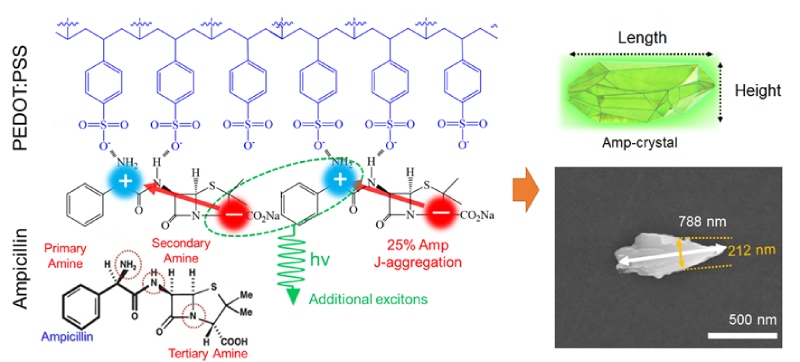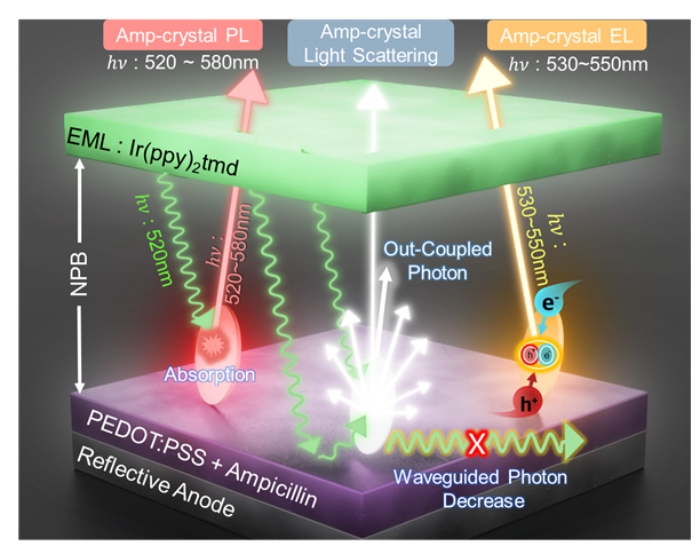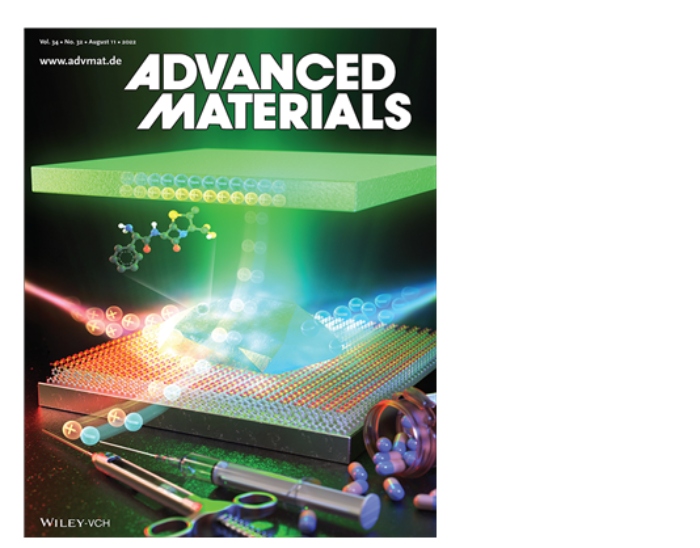Development of Top-Emission Organic Light-Emitting Devices, Based on the Use of Antibiotics
The research results of Professor Ryu Seoung-yoon’s group were published as a cover article in Advanced Materials, an internationally renowned journal in materials science.

▲ (From left) Professor Ryu Seoung-yoon (corresponding author), Kim Dong-hyun (first author, graduate student) and Lee Chang-min (first author, graduate student) of the Department of Display and Semiconductor Physics.
Professor Ryu Seoung-yoon’s group at the Department of Display and Semiconductor Physics has successfully developed high-performance top-emission organic light-emitting devices (OLED) based on the use of antibiotics. The research results were published as a cover article in Volume 34, Issue 32 of Advanced Materials (IF 32.086), an internationally renowned journal (top 1% journal in materials science).
The applications of OLED, which produces excellent device performance and has very efficient properties, are gradually being extended, including to its use in smart phones and TVs. Many studies have aimed to increase the external quantum efficiency (EQE) of OLED, which is the most promising candidate in the quest to achieve progress in the field of display and lighting applications.
Various methods have been employed to increase the EQE, including the use of horizontal emitters, the optical suppression of waveguide or substrate modes, and the electrical enhancement of conductivity and charge injection. These methods involve the use of hole-injection/hole-transport layers, sub-anode structures, scattering layers, and high-refractive-index materials.
Recently, Organic Semiconducting Single Crystals (OSSCs) have been produced with the aim of improving the performance of organic light-emitting materials that have a lower level of carrier mobility and a photoluminescence quantum yield.
In the present study, Professor Ryu’s group developed Amp-MSs, which are a new convergent type of OSSCs based on ampicillin, an antibiotic, in order to drastically improve their efficiency.
In the present study, which is focused on the enhancement of the characteristics of poly(3,4-ethylenedioxythiophene):poly(styrenesulfonate) (PEDOT:PSS), an ampicillin antibiotic that has a large dipole moment (30.28 Debye) was selected as a means of injecting a carrier, and simultaneously generating an interfacial dipole and improving conductivity and photon extraction. Regarding the horizontal/vertical interfacial dipole alignment and the light emission on the part of the aggregates, through Korea University's 2019 Mid-Career Research Program Professor Ryu’s group produced the first example of the application of an antibiotic to photoelectronic devices, and reported the results in the article “The Effect of Introducing Antibiotics into Organic Optoelectronic Devices”, published in Communications Physics, 2:130, pp. 1-13.

▲ Hybrid microstructure of a conductive polymer and an antibiotic.
A schematic of the method of synthesizing a conductive polymer in combination with ampicillin. The microstructure can be formed by combining PEDOT:PSS, a conductive polymer, with ampicillin.
* Ampicillin: A β-lactam-based antibiotic that is used in the prevention and treatment of various infections.
* Conductive polymer: An electrically conductive organic polymer. In this paper, the term specifically refers to PEDOT:PSS.
Through the Mid-career Follow-Up Research Program, Professor Ryu’s group changed the annealing temperature based on the optimal ampicillin concentration to lessen the deviations in the efficiency and stability of the ampicillin-based OLEDs, thereby drastically increasing their efficiency and stability. In addition to the optimization of the annealing temperature, Amp-MSs of various sizes and shapes (α-/β-phase) were synthesized, which led to a variety of energy states.
The OLEDS which improved through the use of Amp-MSs exhibited an average EQE of 63.4%. Three major factors played a part in their improved efficiency. First, Amp-MSs suppressed the waveguide modes and enhanced the photon extraction through optical scattering, accounting for 17% of the EQE improvement. Second, Radiative Energy Transfer, which is the absorption and emission of the light from the emission layer of OLEDs by Amp-MSs, resulted in photoluminescence. Third, the electroluminescence resulting from the hole injection and electron injection into Amp-MSs accounted for 13.7% of the EQE improvement. Additional effects of the Amp-MSs included the improvement of the charge injection balance by the generation of an interfacial dipole, and the redshift of the spectrum by J-aggregation, which improved the color gamut. In addition, it was found that the sodium ions included in the antibiotic formed a sodium sulfide film, which prevented the diffusion of indium ions from the transparent indium tin oxide (ITO) electrode.

▲ Energy-harvesting photoemission by the microstructures.
The microstructures consisting of a conductive polymer and ampicillin are capable of harvesting the injected optical energy and electric energy required to produce light emission, and of reflecting the leaked light in order to reduce the unnecessary waste of energy. This allows for the production of high-efficiency OLEDs.
In this study, Professor Ryu’s group ultimately produced an OLED with an EQE of 63.4%, thereby confirming that the efficiency of photoelectronic devices can be further enhanced.
The combination of an antibiotic with a hole injection layer generated an effect that is similar to the configuration of a tandem structure with two or more emission layers. Therefore, the results produced by the study show that costs can be cut and time saved, and that this technique can be applied to the technologies involved in manufacturing next-generation displays, such as printing electronics.
The article analyzed and described a mechanism for realizing photon-harvesting through the use of Amp-MSs, involving elements such as light scattering and photoluminescence, and carrier-harvesting through the use of electroluminescence and the scattering of Amp-MSs in a single OLED, in this way contributing to the production of a new type of photoelectric device.
In addition, the effective combination of antibiotics and photoelectric devices constitutes a new milestone on the path to applying antibiotics to this field, and to facilitating the development of high-performance photoelectric/bioelectronic devices.
Professor Ryu said, “Our study sprang from simple curiosity about what would happen when an aqueous solution of a conductive polymer is mixed with an aqueous solution of an antibiotic. With the continued support over the course of six years of the National Research Foundation of Korea, through the Mid-Career Research Program and the Mid-Career Follow-Up Research Program, we were able to accomplish much in our research.” He also explained his future research plans. “We have created a next-generation OLED material technology through this study. Based on the results, we aim to develop the advanced materials technologies that will be necessary in the display industry of the future.”
Kim Dong-hyun, who is a graduate student and a first author of the article, commented, “I was able to persist with this research thanks to the zeal of the research group and the scrupulous direction provided by my advisor.” He also said, “The most memorable moment was when we optimized the annealing conditions, acquired experimental reproducibility, and eventually identified the mechanisms behind the improvement of the efficiency.”
Lee Chang-min, who is also a graduate student and also a first author of the article, commented, “The new combination of an antibiotic and a conductive polymer was really an intriguing research topic.” He added, “It was my honor to be able to participate in this research upon joining my Ph.D program, and to work together with great colleagues in the investigation of mechanisms that had not been discovered at that time.”

▲ Pusblished as a cover article
"Efficient Photon Extraction in Top-Emission Organic Light-Emitting Devices Based on Ampicillin Microstructures", Advanced Materials, (2022) 2202866



